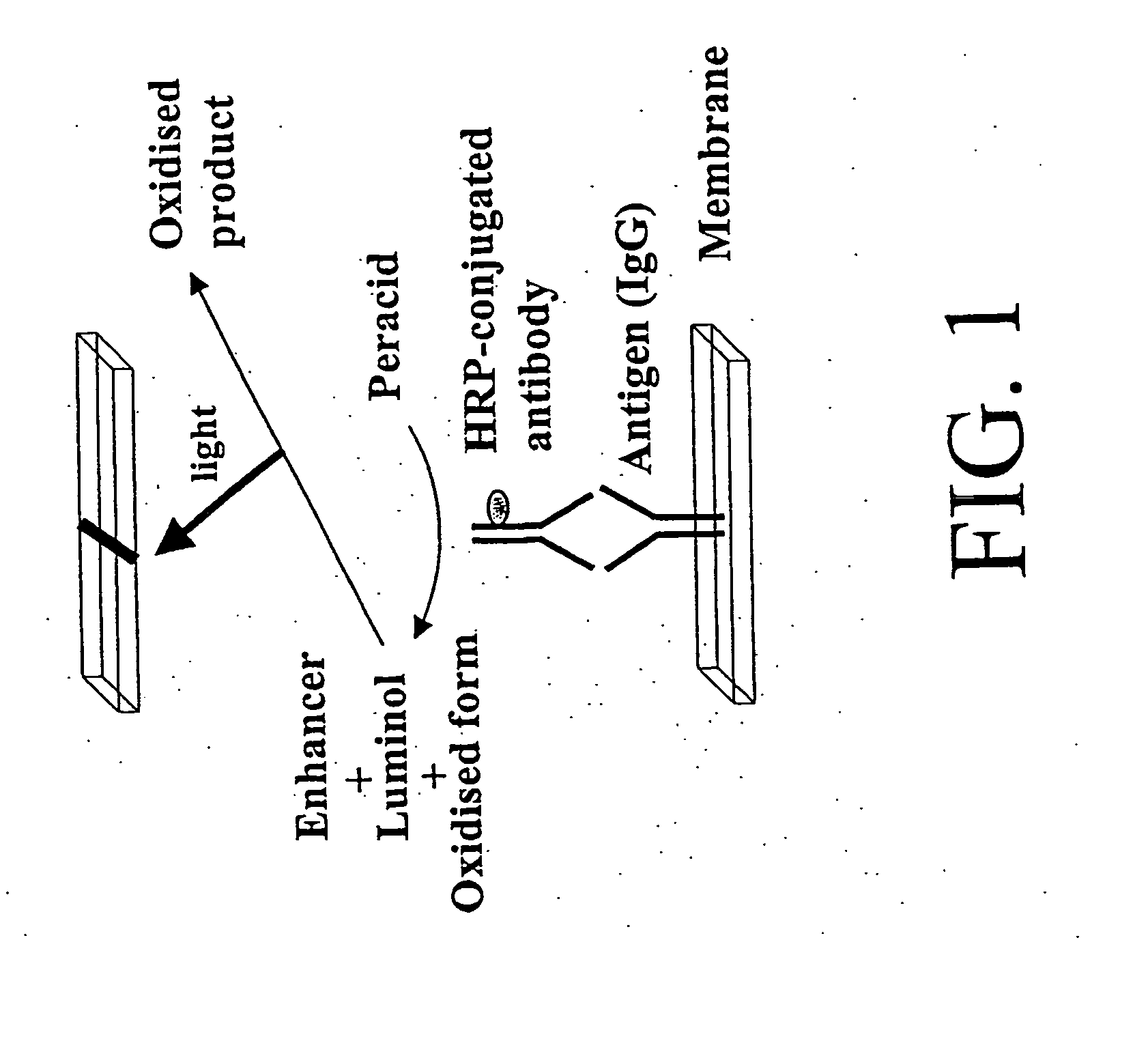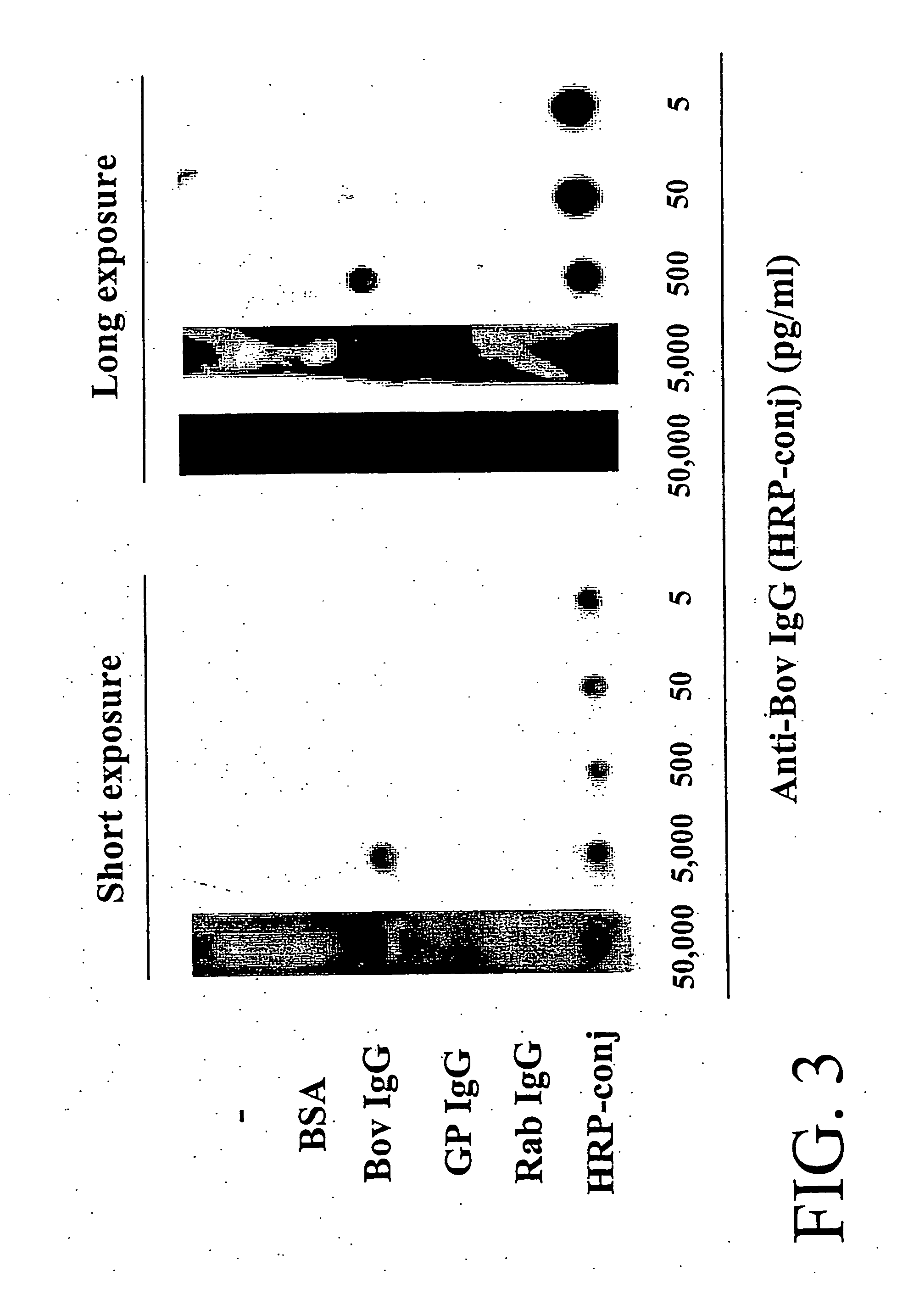Antibody-based protein array system
a protein array and antibody technology, applied in the field of polypeptide and protein analysis, can solve the problems of limited throughput of ionization (seldi), inability to achieve high throughput analysis of proteins in a manner like that enabled by dna microarrays for gene analysis, and insufficient experimental evidence to show significant differences in relative abundance of genes
- Summary
- Abstract
- Description
- Claims
- Application Information
AI Technical Summary
Benefits of technology
Problems solved by technology
Method used
Image
Examples
example 1
Simultaneous Detection of Multiple Proteins with an Array-Based Enzyme-Linked Immunosorbant Assay (ELISA) and Enhanced Chemiluminescence (ECL)
[0092] Our goal in this example was to test the feasibility of simultaneously and specifically detecting numerous proteins using a 96-well based ELISA coupled with enhanced chemiluminescence (ECL) without the use of any expensive machinery. We demonstrated the potential use of this method to detect numerous proteins simultaneously in a general laboratory setting.
[0093] Materials and Methods. Antigens and their corresponding horseradish peroxidase (HRP)-conjugated monoclonal antibodies were purchased from several different companies as shown in Table 1. Antigens and antibodies were prepared as stock solutions (4 mg / ml). Antigens were diluted with TBS (0.01 M Tris HCl pH7.6 / 0.15 M NaCl) to 5 μg / ml as working solutions prior to experiments. One hundred μl of antigens were immobilized onto polyvinylidine difloride (PDVF) membrane (Immobilon, Mil...
example 2
Simultaneous Detection of Multiple Cytokines and Antibodies
[0103] To simultaneously detect multiple proteins and antibodies, a microspot approach was developed. In this approach, capture proteins, either antibodies or antigens, are spotted onto a membrane. The membrane is then exposed to a sample containing a protein, or proteins, of interest. The protein of interest is bound by its cognate, either an antibody or antigen, spotted onto membrane, is thereby immobilized, and its presence is determined by the binding of a detection protein, specifically an HRP-labeled antibody. Detection of the HRP-labeled antibody's presence by enhanced chemiluminescence indicates the presence of the bound antigen of interest, thereby indicating its presence in the sample.
[0104] As a first step, a simplified system was applied to test the feasibility of this assay. Various known specific immunoglobulins (Igs) were spotted onto membrane and detected by incubation with HRP-conjugated antibodies specifi...
example 3
Detection of Multiple Cytokines from Conditioned Media and Patient's Sera
[0119] This example describes a highly sensitive ELISA-based protein array system in which multiple cytokines can be simultaneously detected from the experimental model system, from tissue culture media and from sera from patients. After identifying a candidate protein for analysis, this system allows hundreds of biological samples to be analyzed quantitatively using a single array membrane.
Materials and Methods
[0120] Antibodies were purchased from BD PharMingen (San Diego, Calif.). All of cytokines except GROα and granulocyte colony stimulating factor (G-SCF) were obtained from Peptotech (Rochy Hill, N.J.). GROα and G-SCF were the products of BD PharMingen. HPR-conjugated streptavidin was also purchased from BD PharMingen.
[0121] Preparation of array membranes. An array of 504 spots (28×18) on a 6×8 cm membrane was generated using a template to guide manual spotting onto a membrane. Capture antibodies were...
PUM
 Login to View More
Login to View More Abstract
Description
Claims
Application Information
 Login to View More
Login to View More - R&D
- Intellectual Property
- Life Sciences
- Materials
- Tech Scout
- Unparalleled Data Quality
- Higher Quality Content
- 60% Fewer Hallucinations
Browse by: Latest US Patents, China's latest patents, Technical Efficacy Thesaurus, Application Domain, Technology Topic, Popular Technical Reports.
© 2025 PatSnap. All rights reserved.Legal|Privacy policy|Modern Slavery Act Transparency Statement|Sitemap|About US| Contact US: help@patsnap.com



